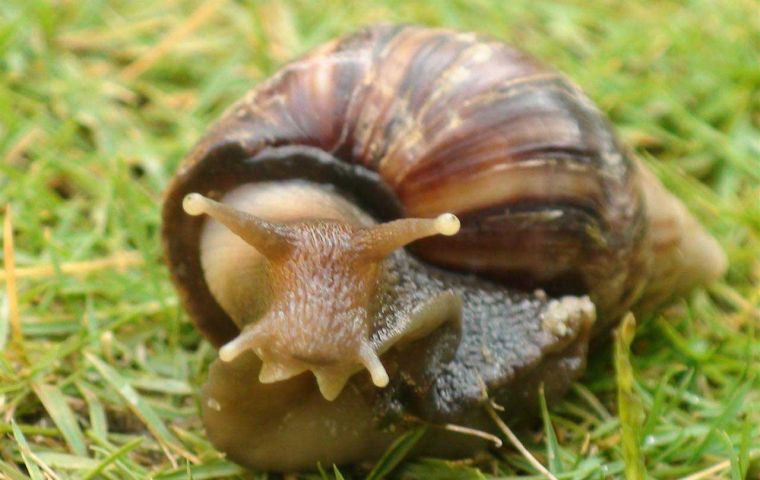MercoPress. South Atlantic News Agency
Highly invasive, voracious and dangerous African snail found in Paraguay
 Achatina fulica was probably introduced from Brazil, suspect Paraguayan officials
Achatina fulica was probably introduced from Brazil, suspect Paraguayan officials The giant East African snail, (Achatina fúlica), listed among the world’s top 100 invasive species, extremely voracious and which can transmit deadly diseases to humans has been found in empty lots in the Paraguayan city of Ciudad del Este, next to Brazil.
As they develop rapidly and produce large numbers of offspring, the giant African land snail is recognized as a serious pest organism affecting agriculture, natural ecosystems, commerce, and human health.
Surprised neighbours reported the presence of the snails to the authorities which finally located twenty of them and said it was the first time the species was detected in Ciudad del Este, although some Achatina fulica were also found in the city of Ayolas, on the Paraná river across from Argentina.
Dr. Adolfo Calcena head of the Regional Sanitary Office in the city warned that the snail is poisonous and can transmit meningitis, bronchial disorders, encephalitis plus other serious contagious diseases.
Elio Mendoza from Paraguay’s Veterinary Services called on parents to watch out for the children that in summer months go around barefooted and could easily be infected by the giant snails. Adult snails have a height of around 7 centimeters and their length can reach 20 centimeters or more.
Mendoza said that his office suspects the snails were brought from Sao Paulo in Brazil for Paraguayan restaurants, and were later abandoned when it was discovered not only that they reproduce rapidly but are venomous. He suggested that the way to eliminate them, always wearing gloves, is to spray the snails with brine and lime, and if possible bury them two meters deep. Another product is chlorine products used for cleaning floors at homes.
However squashing or burning them is not recommended since they reproduce very fast, are hermaphrodites and lay anywhere from 100 to 400 eggs.
Mendoza said that special teams with members from the ministries of Health, Environment and Veterinary Services will be checking along the coast of the Paraná River since it is feared they could have quickly adapted to the ecosystem.
“The giant African land snail is a voracious predator and a plague for farmers which quickly destroys crops”, warned Mendoza. “The easiest way to transmit diseases is if the contaminated mucus comes in contact with human mucus be it in eyes, nose or mouth. That is why they must always be manipulated with gloves on, and a spade to collect them”.


Top Comments
Disclaimer & comment rules-

-

-

Read all commentsHysterical “Dommsday Preppers” article.....
Dec 15th, 2012 - 09:49 am 0The have been here in SA since, at least, the sixties.....
and they taste great!
I know most invasive snails where they are
Dec 15th, 2012 - 10:18 am 0not in the nature but in the political parties........
This looks a lot like that Crissy kirchner shes a slimy cat LOL
Dec 16th, 2012 - 12:32 am 0Commenting for this story is now closed.
If you have a Facebook account, become a fan and comment on our Facebook Page!